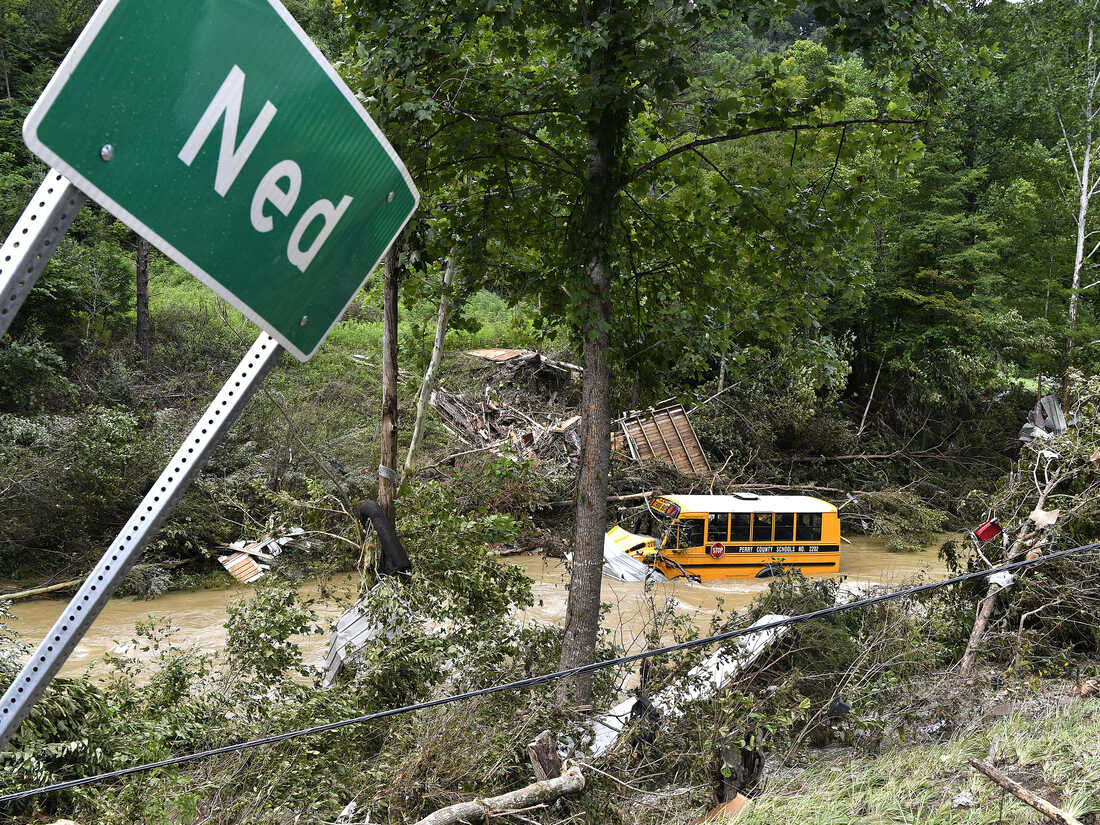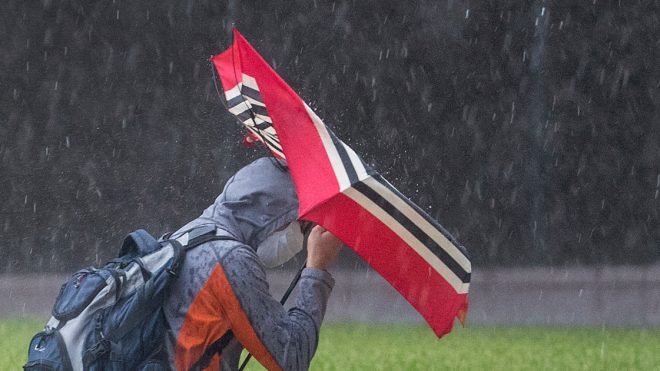
Following its Friday entanglement in the floodwaters of Lost Creek in Ned, Kentucky, a Perry County school bus lies in ruins.
AP Photo/Timothy D. Easley KY – FRANKFORT The governor of Kentucky warned that it would take weeks to locate all the victims of the flash flooding that swept through Appalachian villages after torrential rains, killing at least 25 people.
Governor Andy Beshear predicted on Saturday that the victims’ toll would certainly increase dramatically as a result of the recent record-breaking flash flooding.
Beshear told Fox News that the natural tragedy was still ongoing. “Still engaged in search and rescue operations. The rain has thankfully stopped. But beginning Sunday afternoon, it will rain more.”
Rescue teams are still fighting to enter some of the most impoverished sections of America in hard-hit districts. The governor reported that more than 1,200 rescues were performed by crews using boats and helicopters.
After falling between 8 and 10 1/2 inches (20-27 cm) in certain areas of eastern Kentucky during the previous 48 hours, the rain stopped early on Friday. However, Saturday was predicted to be the crest for certain waterways.
WEATHER When Patricia Colombo’s automobile stalled in floodwaters on a state highway in Hazard, Kentucky, she was left stranded. Patricia is 63 years old. Water was pouring in, and Colombo started to panic. She waved down a chopper even though her phone was dead since she noticed it overhead. She was rescued after the helicopter crew radioed a ground crew.
Colombo spent the night at her fiance’s house in Jackson, where they alternated shifts sleeping while periodically using torches to check on the water to see if it was rising. Although Colombo’s automobile was a total loss, she claimed that others in the area, where poverty is pervasive, had it worse.
“Many of these patients are unable to heal here. They lost everything, their homes are partially submerged “She spoke.
It’s the most recent in a series of disastrous downpours that have wreaked havoc on several regions of the United States this summer, including St. Louis earlier this week and once more on Friday. Climate change, say scientists, is increasing the frequency of weather disasters.
This week’s torrential downpours in Appalachia caused water to cascade down hillsides and into valleys and hollows, enlarging the rivers and streams that flowed into small villages. The torrent destroyed cars and inundated residences and businesses. Some people were trapped on steep slopes by mudslides.
National Rescue teams supported by the National Guard looked for the missing using boats and helicopters. Beshear stated on Friday that there were at least six children among the deceased and that as rescue crews expand their reach, the overall death toll may more than quadruple. Four children from the same family in Knott County perished, according to the county coroner’s report on Friday.
In a social media post, President Joe Biden claimed to have spoken with Beshear on Friday and pledged the support of the federal government. In order to provide aid funds to more than a dozen Kentucky counties, Biden also declared a federal disaster.
Southern West Virginia and western Virginia were both affected by the flooding.
For six counties in West Virginia, where the floods caused trees to fall, power outages, and obstructed roadways, Governor Jim Justice issued an emergency declaration. Glenn Youngkin, the governor of Virginia, also declared an emergency, allowing authorities to mobilize personnel throughout the flooded southwest of the state.
According to poweroutage.us, about 6,100 utility customers in Virginia and more than 20,000 in Kentucky were still without power as of late Friday.
According to scientists, as the earth becomes hotter and weather patterns change as a result of climate change, extreme rain events have increased in frequency. Because models used to predict storm impacts are in part based on past occurrences, they are unable to keep up with the increasingly destructive heat waves and flash floods like those that have recently struck the southern Plains and Pacific Northwest.
WEATHER The United States is currently experiencing a battle of extremes, according to Jason Furtado, a meteorologist at the University of Oklahoma. “We anticipate these outcomes as a result of climate change. More water vapor is held in an atmosphere that is warmer, which makes it possible to produce more heavy rains.”
The flood came two days after St. Louis saw record rainfall that dumped more than 12 inches (31 centimeters) of rain and resulted in at least two fatalities. Over 10,000 people had to be evacuated last month as a result of unprecedented floods brought on by torrential rain on snow-covered mountains in Yellowstone National Park. In all cases, the amount of rain and floods considerably outpaced forecasts.
According to Floyd County Judge-Executive Robbie Williams, the floodwaters roaring over Appalachia were moving so quickly that some residents stuck in their homes couldn’t be rescued right away.
Authorities in Perry County, which was severely affected, just to the west, said that some persons were still missing and that practically everyone in the region had some form of damage.
Jerry Stacy, the county’s emergency management director, stated that there was still much searching to be done.
According to Beshear, more than 330 people have sought refuge. Additionally, the governor set up an online fundraising gateway for the victims because the property destruction was so severe.
Beshear estimated that it would take over a year to finish the reconstruction.
At least 28 state roads in Kentucky had portions of them obstructed by flooding or mudslides. Rescue teams worked to reach folks in West Virginia and Virginia where the roads were impassable.












